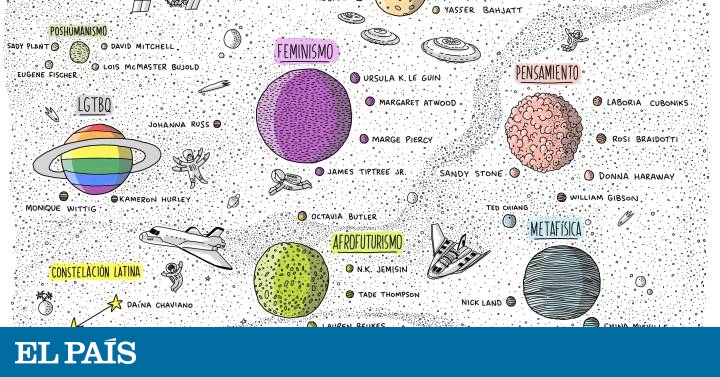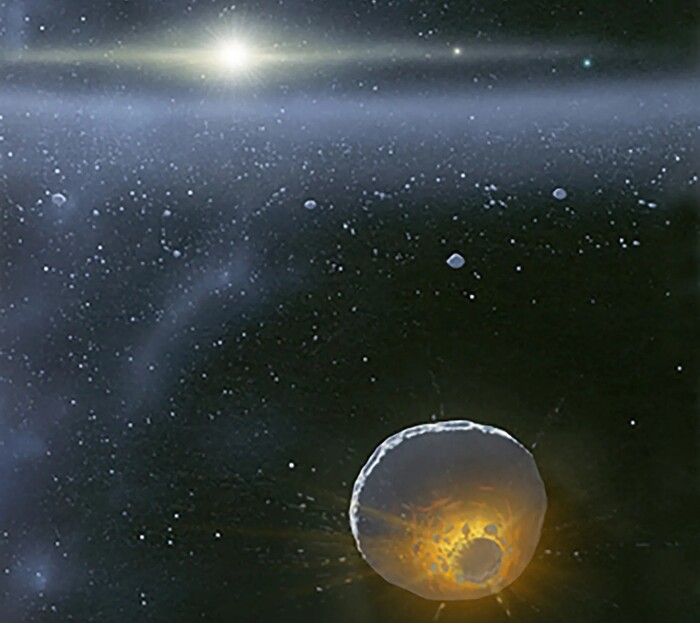The unusual condition of science fiction in the post-Great Recession world as a sum of policies, sensitivities, knowledge and imaginative potentials, with the power to give voice to the global concerns of our time, is clearly reflected in the work of Ted Chiang.
Born in the United States but of Chinese descent, with a degree in Computing and very familiar with the dialects of technology and science, it is logical that Chiang's concerns as a writer of (science) fiction go through linguistics and the meta-story, as are evidenced by his short novels
La historia de tu vida
(1998) —germen from the film
The Arrival
(2016), by Denis Villeneuve— or
The Life Cycle of Software Objects
(2010).
Chiang's great discovery lies in contributing to a classic aspect of the genre -
hard
science fiction
,
concerned above all with the first meaning of the term, that which refers to science - anthropological and metaphysical facets tinged with melancholy.
Authors with interests similar to yours include Gish Jen and China Miéville.
Anticipation tests
If Ted Chiang has contaminated the narrative with essay aspects, the academic and philosopher Donna Haraway has traveled the path in the opposite direction.
Since her founding text,
Manifesto for Cyborgs,
in 1985, Haraway has supported her visionary feminist reflections on the body, technology, culture and language in concepts linked to cinema and science fiction literature.
The mutation of his thinking over the last three decades has shown an extraordinary coherence and evolutionary capacity towards a transgressive vision of ecology, crystallized in
Continuing with the problem: generating kinship in the Chthuluceno
.
Her work has inspired numerous
language and gender
hacktivists
, whose manifestos has been compiled by
Cyberfeminism: From VNS Matrix to Laboria Cuboniks,
edited by Remedios Zafra and Teresa López-Pellisa.
Against the patriarchal canon
In turn, Haraway's commitment to transcending the male-female binarism through the post-human has antecedents in
The Left Hand of Darkness,
which a pioneer like Ursula K. Le Guin published in 1969, and
The Female Man,
by Joanna Russ, published in 1975. Both novels are forerunners of an entire literary movement that questions assignments and rights
, including reproductive: from
the Handmaid's tale,
Margaret Atwood, until
new mother,
Eugene Fischer, or the anthology
ProyEctogénesis,
published in 2019.
The American writer Kameron Hurley recalls: “Women in this country are 40% of science fiction writers and 70% of readers (…).
Our voices can no longer be denied or dismissed.
We have come to stay ”.
His words give an account of one of the main characteristics of the
boom
that science fiction is currently experiencing: the triumph of feminist and
queer
perspectives
,
which have cast a critical eye on the heteropatriarchal and dominant white canon in the history of the genre. what happens through the vindication of figures so far in the background.
These new sensibilities have been able to contribute to the present of science fiction, especially in the literary field, an unprecedented variety of approaches.
The future and the diaspora
But what Kameron Hurley could not foresee in his landmark essay
The Geek Feminist Revolution
(2016) is to what extent the intersectionality of feminist and
queer
perspectives
has become embedded in a movement of even greater resonance;
a whole constellation of meanings around science fiction of which, in an increasingly essential way, plural discourses of race, class and sexual identity are part, whose origins are located in geographical and cultural coordinates distant from the
Anglo-Saxon
mainstream
.
If the aforementioned
The Left Hand of Darkness
and
The Female Man
were pioneers in their formulation of dystopian realities and utopian possibilities for women, the African-American Octavia E. Butler added the racial factor to her own speculative fiction:
Kinship
(1979), the The
Xenogenesis
trilogy
(1984-89) or the anthology
Daughter of blood and other stories
(1996-2005) have become references of Afrofuturism, the current that fables about the African diaspora derived from slavery.
Butler's witness has been picked up by voices such as NK Jemisin
(Fragmented Earth Trilogy,
2015-2017) and Nnedi Okorafor
(Binti Trilogy,
2015-2018), so popular that they were later claimed by the
comic book
industry
.
In contrast, Chicano science fiction, a spiritual debtor to the Mexican diaspora in the United States, is still awaiting international recognition for works of worship such as
Lunar Braceros: 2125-2148
(2009), by Beatrice Pita and Rosaura Sánchez.
Constellations to discover
Other latitudes do begin to make themselves heard strongly.
In China, science fiction has played a decisive strategic role in the economic and technological development of the country.
Although the anthology of short stories
Planets invisibles
(2017) discovered a handful of Chinese writers to take into account for the Spanish reader, there are those who already shine with their own light.
In particular, Cixin Liu with
The Three Bodies Trilogy
(2006-10), but also Hao Jingfang, author who, in the story
Between the folds of Peking
(2012) and the novel
Vagabundos
(2016), has imagined utopias mediated by political dissonances.
Women are the absolute protagonists of Nordic science fiction, with Finns Emmi Itäranta and Johanna Sinisalo as prominent names.
And also from the Russian: Anna Starobinets is considered one of the best science fiction authors for her approach to the genre from estrangement.
Africa stands out in a complex mosaic: South African Lauren Beukes (
The Luminous,
2013) represents an established side of the genre, while elsewhere the trend is taking off.
The short story anthology
Afrofuturo (s): a window into African science fiction,
published in 2017, offers the opportunity to get closer to a science fiction that takes its first steps in tune with the establishment of the middle class in countries such as Kenya and Nigeria, and invokes imaginary of the future from a mythical past.
The same should be noted in Asia regarding the so-called Persian Gulf Futurism, although authors such as the duo formed by Ibraheem Abbas and Yasser Bahjatt, from Saudi Arabia, and Noura al Noman, from the United Arab Emirates, are marked by the mark of the
young adult
western.
Astral Latin America
History of Latin American science fiction. From the origins to modernity
(2020) and
Unusual.
Narrators of the Fantastic in Latin America and Spain
(2018) represent relevant introductions to the past and present of science fiction written in Latin America and its interconnections with our country.
But we cannot forget consolidated figures such as the Argentine Angélica Gorodischer, author of a classic like
Kalpa Imperial
(1983), or the Cuban Daína Chaviano, who combines utopian thought, mythology and scientific fiction in her latest novel,
Los Niños de la Diosa Huracán.
(2019).
The new literary batch of those latitudes is made up, among others, of the Argentine Laura Ponce, whose collection of stories
Deep Cosmography
(2018) is a succession of disturbing interior landscapes;
his compatriot Teresa P. Mira de Echeverría, in whose anthology of short stories
Ten variations on love
(2015) meet the
new weird
and gender fluidity;
Like Luis Carlos Barragán, he also advocates in
Vagabunda Bogotá
(2011) and
El gusano
(2018) for intertwining the surreal with the
queer
to allegorically deconstruct his native Colombia.
Spanish nebula
In Spain, Rosa Montero has made the adventures of Bruna Husky, a techno-human detective from the future, a best seller, and Elia Barceló has been a resistant since times less favorable for science fiction than today, who has contributed key titles such as
Sagrada to the
local ecosystem
(1989) and
The Flight of the Hippogriff
(2002), while Lola Robles and Concepción Regueiro published a
queer
science fiction anthology
published in our country:
Histories of the Crazy Bar and other stories of the impossible
(2013).
The relay is carried out in our days by a new generation very aware of how science fiction is a privileged space to deal with issues related to gender programming, understood from the anthropological point of view and the structures of language, thought and action.
Titles such as
The strange look
(Felicidad Martínez, 2016),
Connerland
(Laura Fernández, 2017),
Umbra
(Silvia Terrón, 2018),
UNO
(Nieves Delgado, 2018),
The door of heaven
(Ana Llurba, 2018),
Bionautas
(Cristina Jurado, 2018) and
Newropía
(Sofía Rhei, 2020) share the dominance of the genre and, at the same time, the ambition to subvert its constants.
Finally, it is necessary to vindicate the field of comics, which is promoting science fiction as stimulating as novels.
Emma Ríos has reflected in
ID
(2016) about identity, and in
Mirror,
created together with Hwei Lim, about the coexistence between species.
And Anabel Colazo has revealed in
Close Encounters
(2017) and
Don't Look Back
(2019) an approach to gender nuanced by the treatment of phenomenologies such as
creepypastas
or UFOs from pop culture.
Elisa McCausland
is a critic and researcher specializing in popular culture and feminism, author of
Wonder Woman: Feminism as a superpower,
and co-author of
Supernovas.
A feminist history of audiovisual science fiction
, both published by Errata Naturae.












